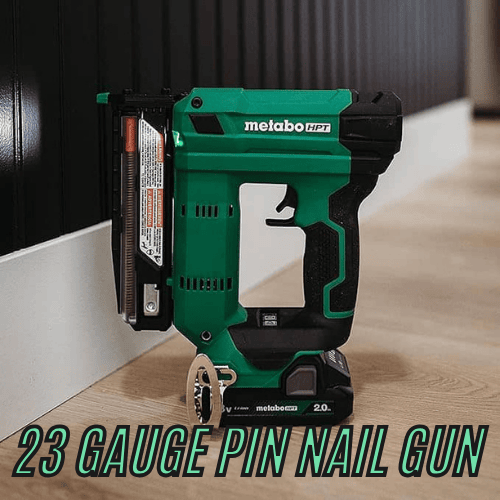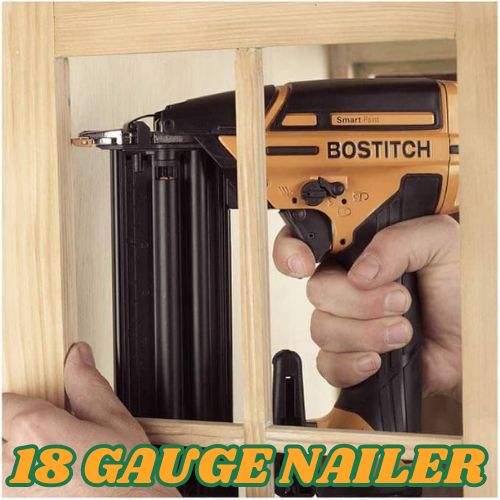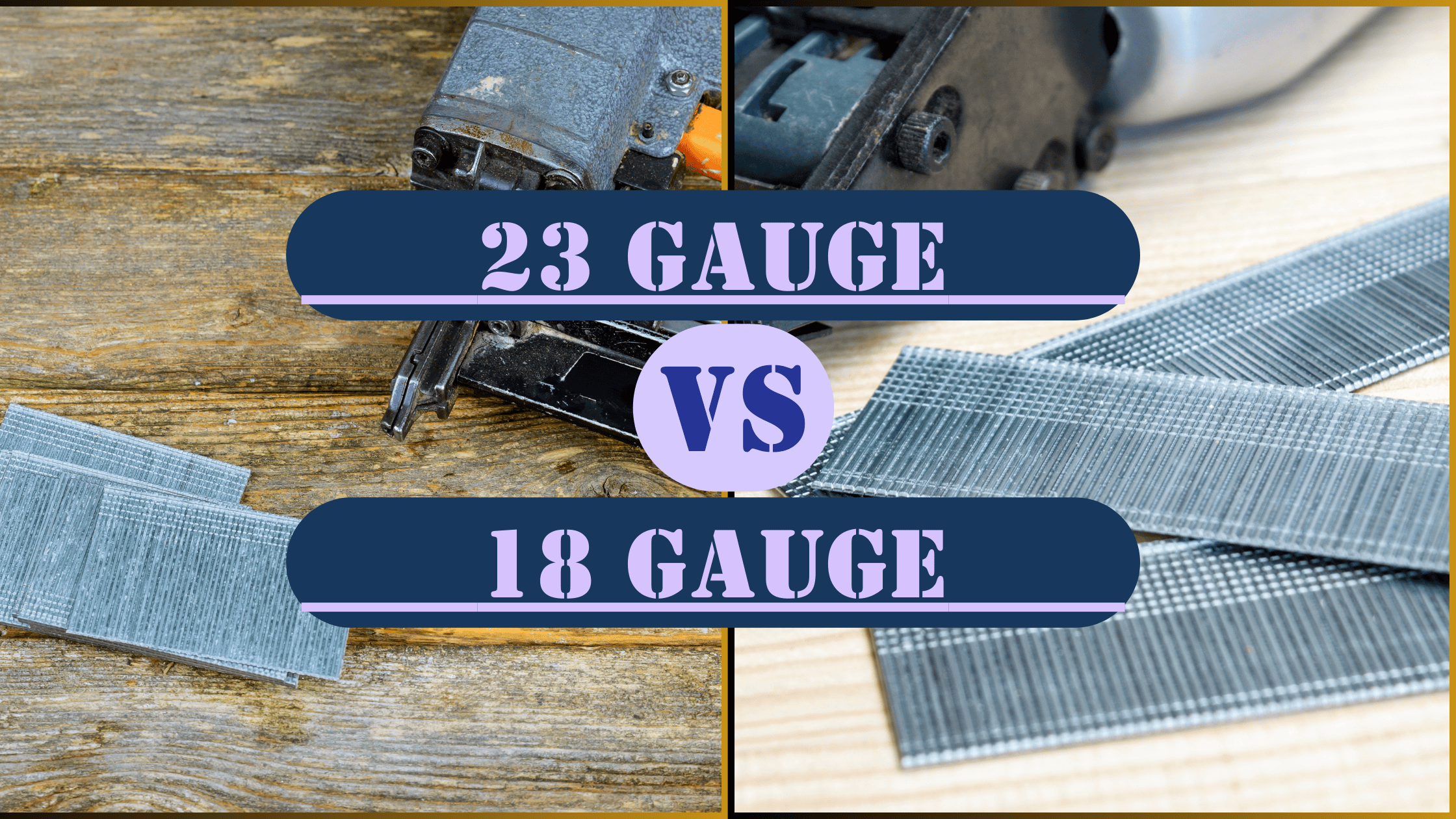According to recent industry surveys, the difference between 18 and 23-gauge nails is one of the most common dilemmas faced by both beginners and seasoned pros. While they might seem similar at first glance, these two tools are designed for different tasks and have distinct advantages and limitations. In fact, these two nail gun sizes account for over 65% of finish nailer purchases!
Having spent years in custom carpentry, I can tell you that choosing the right nailer can make or break your project’s outcome. Let’s nail down everything you need to know!
What is a 23 Gauge Nailer?

The 23 gauge pin nailer has excellent precision. These tools drive ultra-thin pins that become nearly invisible once they’re in place. 23 gauge nailers use headless or micro-headed pins. These pins have lengths of 1/2″ to 2″. The holes made by a 23 gauge nailer are virtually undetectable. Also, 23 gauge nailers have a low risk of splitting even if the material is fragile. Its magazine capacity is typically 100-200 pins. For high-quality models of 23 gauge nail guns, the price range would be around $99-$299
This 23 gauge pin nail gun is available in two models. One is 23 gauge air nailer and the other one is a 23 gauge cordless nail gun. The 23 gauge air pin nailer is operated by an air compressor whereas cordless 23 gauge nailer is operated by rechargeable batteries.
23 Gauge Pin Nail Gun – Pros and Cons
Pros
Precision
A 23 gauge nailer has precision like no other nailer. Its fine detailing ability is every perfectionist’s dream. If you are working on a delicate project, a 23 gauge nailer is your best bet.
Minimal Holes
If you are working on an expensive or high-end piece of furniture and you want the holes to be nearly invisible, you should use a 23 gauge nailer. Its ultra-thin pins leave almost undetectable holes that are easy to fill or hide.
Less Splitting
Softwoods are easy to split if the nails are on a thicker side. If you are worried about your material getting split, use a 23 gauge nailer. It uses thin nails and you don’t need to worry for your material to split ever again!
Low Recoil
The 23 gauge nailers have very little recoil. As a result, these are very easy to control. This characteristic of the 23 gauge nailer makes it a more beginner-friendly option.
Lightweight and Compact
The 23 gauge nailer is very lightweight (usually around 1-2 lbs). Moreover, it is small in size, making it comfortable to handle. Its lightweightness makes it comfortable to handle for a longer time even when working in compact places.
Minimal Dust and Mess
23 gauge nailers don’t leave behind much debris or mess because they use thin nails that have small heads or no heads. Working with a 23 gauge nailer keeps your workspace cleaner.
Cons
Not For Heavy-Duty Projects
As a 23 gauge nailer uses thin nails, It’s not a smart choice to use it in heavy-duty tasks. Its nails may not penetrate well or can break in this process.
Low Holding Power
The nails used in a 23 gauge nailer lack the holding power for larger projects. It should be used for projects that do not require much holding power or use materials that are less hard.
Expensive
A 23 gauge nailer can be expensive compared to its versatility. It has less holding power but is more expensive than other nailers that possess more holding power. Also, it uses thin nails that are not suitable for penetrating a variety of materials well.
Not Ideal for All Materials
The 23 gauge nailer uses 23 gauge pin nails that are not suitable for dense, hardwood or materials that require higher holding power.
23 Gauge Nailer Uses
When precision is your top priority, a 23 gauge nailer is your best choice. Here are some of the best uses of a 23 gauge nailer:
Delicate Trim Work
As a 23 gauge nailer uses thin nails, it gives a clean and almost invisible finish to the projects. This nailer is perfect for fine molding. It can also be used in small trims where you need to be very precise.
Small-Scale Projects
It needs great control to work on small furniture, delicate cabinetry, or intricate woodwork. 23 gauge nailer will give you the control you need in this case.
Cabinetry Construction
If you want to assemble small cabinets or other wood pieces, a 23 gauge nailer is ideal for you to use. The tiny nails hold trim, backs, and shelves in place without leaving visible holes.
Woodworking and Model Building
Small models of buildings, furniture, or intricate wood joining need great precision because the nail holes need to be invisible. In this case, 23 gauge nailers are the best choice, because they leave almost undetectable nail holes.
Installing Decorative Molding
Decorative works need a cleaner and more flawless finish. Whether it’s chair rail molding, wainscoting, or picture frames, nothing can beat the neat and smooth finish of a 23 gauge nailer.
When Aesthetics is key
When you’re working on costly furniture, for example, attaching the trim to an expensive cabinet, the smaller and thinner nails of a 23 gauge nailer are less noticeable. Also, they leave a neat finish. So, if you are working on projects that demand flawless finishes, a 23 gauge nailer is your friend.
What is 18 Gauge Brad Nailer

The 18 gauge nailer is a dependable, heavy-duty nailer that you can rely on for a wide range of projects. It is a brad nailer that uses brad nails with small heads. Its nail heads usually range from 5/8″ to 2 1/2″ in length. It leaves a slightly visible hole in the material. The 18 gauge nailer has a superior holding power compared to the 23 gauge nailer. The magazine capacity of this nailer is 100-150 brad nails. If you want to get a professional model 18 gauge nailer, the cost would be around $129-$399.
18 Gauge Nailers – Pros and Cons
Pros
Higher Holding Power
An 18 gauge nailer possesses more holding power than a 23 gauge nailer because it uses stronger nails. Also this nailer can be used in a variety of materials.
Versatility
If you want a nailer for medium-duty carpentry, trim or cabinetry, an 18 gauge nailer would be your best choice. It is a versatile tool that can be used for a variety of materials. It is an all-around tool
Affordable Nails
18 gauge nails are more affordable than the 23 gauge pin nails. So, the 18 gauge nailer is a cost-effective option for both professionals and beginners.
Wide Range of Nails Length
Nails of a broader length range can be used in an 18 gauge nailer which makes it suitable for a variety of tasks.
Faster Firing Speed
18 gauge nailers typically have a faster firing speed that makes the projects less consuming.
Efficiency
An 18 gauge nailer is faster than other nailers. So, it is efficient for larger projects as it takes less time for its fast pace.
Cons
Larger Holes
18 gauge nailers leave larger holes than 23 gauge nailers because the nails used in these nailers are thicker than those used in a 23 gauge nailer. The holes need to be filled in order to get a clean finish.
Heavier and Bulkier
The 18 gauge nailer is heavier and bulkier than the 23 gauge nailer. So using it for longer projects may cause hand fatigue.
Splitting
As 18 gauge nailers use nails that are on the thicker side, it can cause splitting in delicate woods like pine or MDF. So it is best not to use an 18 gauge nailer if you are planning to work on a softer material.
Less Precision
If you are searching for a nailer to work on high-end or expensive furniture, then you should not choose 18 gauge nailers. This nailer is less precise to work with. So in case of intricate detailing or small trims, it would be better not to choose an 18 gauge nailer.
18 Gauge Nail Gun Uses
If you need a nailer that can handle various materials for a larger project, 18 gauge nailers would be your best choice.
Larger Trim Projects
When you are working with baseboards, 18 gauge nailers would be perfect as their stronger nails can hold the larger pieces in place. In case of crown molding or wainscoting, this nailer is a good choice because it has excellent holding power and can give you more security than a 23 gauge nailer.
Furniture Assembly
The 18 gauge nailers can be used for assembling furniture pieces. It would be a perfect choice for attaching sides, backs, and trim on cabinets, bookshelves, tables, etc.
Hinge Installation
18 gauge nailers have a stronger holding power. As a result, they would be a good choice when installing door hinges, hardware, and other fixtures that need a more secure attachment than what 23 gauge nailers can provide.
Upholstery Work
For projects like, attaching fabric to wood frames or securing other upholstery-related components, the 18 gauge nailer offers enough holding power without damaging the fabric.
Heavy-Duty Work
The 18 gauge nailer is a nailer for Heavy-Duty work. For projects that need extra strength, this nailer is suitable. For projects like door framing or cabinetry, the 18 gauge nailer will provide the required holding power.
Flexibility
18 gauge nailers can handle a variety of materials. If your projects require various types of materials, from softwood to hardwoods and plywood, an 18 gauge nailer would be your best bet.
Key Comparisons – 18 or 23 Gauge Nailer
Holding Power
A 23 gauge nailer has limited holding power whereas an 18 gauge nailer’s holding power is excellent. Adhesives need to be used when working with a 23-gauge nailer but 18-gauge nailers can often work without adhesives.
Wood Splitting Risks
In the case of a 23 gauge nailer, the risk of the material getting split is very low because it uses thinner nails. But as an 18 gauge nailer uses nails that are thicker, the possibility of the wood getting split is higher.
Ease of Use
As a 23 gauge nailer is lightweight and maneuverable, it is easy to use. On the other hand, using an 18 gauge nailer is a little difficult because it is slightly heavier but still manageable.
Nail Visibility
The nails used on a 23 gauge nailer are thin. So they are nearly invisible when driven into the material. The 18 gauge nailers use brad nails that are slightly thicker than the nails used in a 23 gauge nailer, so they leave small holes that typically need filling.
Cost Per 1000 Fasteners
The cost for 1000 Fasteners to be used in a 23 gauge nailer is $8-12. On the other hand, it’s $5-8 for 1000 fasteners of an 18 gauge nailer.
23 Gauge vs 18 Gauge Nailer – At a Glance
| Attributes | 23 Gauge Nailer | 18 Gauge Nailer |
| Nail Length | 1/2″ to 2″ | 5/8″ to 2-1/2″ |
| Magazine Capacity | 100-150 Nails (It Varies on Models and Brands) | 100-120 Nails (It Varies on Models and Brands) |
| Weight | 2-3 lbs (It Varies on Models and Brands) | 3-4 lbs (It Varies on Models and Brands) |
| PSI | 60-120 PSI | 70-120 PSI |
| CFM | 0.4-0.6 CFM | 0.6-1.0 CFM |
| Nails Per Minute | 80-100 nails per minute | 60-100 nails per minute |
| Holding Power | Low to Moderate | Moderate to High |
| Suitability of Materials | – Thin, softwood trim – Veneer – MDF – Plywood | – Softwood – Hardwood – Plywood – MDF |
| Hinge Installation | Not Ideal | Excellent for hinge and hardware installation |
| Nail Hole Appearance | Minimal or virtually invisible | Slightly larger holes, visible but still easy to fill |
| Accuracy | High Precision and Accuracy | Good accuracy, though slightly larger holes may be visible |
| Recoil | Very low recoil, ideal for fine detailed work | Moderate recoil, but manageable for general application |
| Durability | High, but nails can bend or break in harder woods | High durability, nails are more robust and less likely to bend |
| Cost (Tools) | Generally more expensive | Generally less expensive |
| Noise Level | Low, quieter operation | Moderate, slightly louder than 23 gauge |
| Cost of Nails | More expensive nails | Less expensive nails |
| Best Use | – Delicate trim work -Molding -Cabinetry -Baseboards | – Framing light trim – Paneling – Molding – Furniture construction |
Which Nailer is Better?
There is no straightforward answer to this question as it depends on the kind of project you’re working on. Both nailers have their pros and cons, so you need to decide which one is more appropriate for your needs.
If you are opting for some detailed, intricate work or trying to assemble a small or expensive piece of furniture and looking for an option that is lightweight, less messy, and gives a smooth and clean finish, you should go for a 23 gauge nailer.
On the other hand, if you want a nailer for more versatile use if your projects require the use of a variety of materials, an 18 gauge nailer would be your best choice.
It simply comes down to choosing which one is best for the task. So, make sure you do your research and learn about the material you’re working with to determine which one is better.
Final Words on 18 vs 23 Gauge Nailer
The choice between a 23-gauge and an 18-gauge nailer depends on what you intend to do with them. If you want a precise, clean finish and the material is on the softer side, you should use a 23-gauge nailer. Also, if you are going to work on an expensive piece, a 23-gauge nailer is the right choice. If you are just starting your woodworking journey and you need one nailer for various materials, you can easily choose an 18-gauge nailer.
I hope you have found the article useful. If you have further questions, please feel free to ask in the comment box. I’d love to help you with all the necessary information about this.
FAQs on 23 vs 18 Gauge Nailer
1. What is the main difference between a 23 gauge and an 18 gauge nailer?
The primary difference is the thickness of the nails used in them. A 23-gauge nailer uses thinner, smaller nails. An 18-gauge nailer, on the other hand, uses thicker, stronger nails.
2. Is an 18 gauge nailer suitable for fine finish work?
An 18-gauge nailer can be used for fine finish work, but it leaves slightly larger holes than a 23-gauge nailer. If your project requires a flawless, almost invisible finish, a 23-gauge nailer is the better choice.
3. Which nailer is better for hardwood projects?
Since 23 gauge nails are very thin and headless they are not perfect for hardwood projects. 18 gauge nailers also provide small-headed thin nails that are not too strong than 23 gauge. Because of thinness, they will not penetrate deep into the hard materials. If you plan to work on hardwood then a 15 or 16 gauge nailer is the best option.
4. Can I use 23 gauge nails in an 18 gauge nailer?
No, 23-gauge nails are too small to fit in an 18-gauge nailer. Each nailer is designed to use specific sizes of nails, so it’s important to match the nail gauge to the corresponding nailer. If one uses the wrong nails, it can cause jams or damage to the tool.
5. Which nailer is more common among professionals?
While both tools are useful, the 18-gauge nailer is generally more common among professionals due to its versatility. It is widely used for a variety of tasks, from trim to cabinetry.
6. Which nailer should I choose if I’m a beginner?
If you’re just starting out with woodworking or DIY projects, an 18-gauge nailer may be a more versatile choice. It can handle a wider variety of projects and materials and will give you more flexibility as you learn. A 23-gauge nailer, while great for detailed work, is better for experienced users who require a high level of precision.
7. What’s the maximum thickness of wood for a 23 gauge nailer?
Most 23 gauge pins can effectively penetrate up to 1-1/2″ of material. However, for best results, stay under 1″ total thickness when joining two pieces.
8. Do I need an air compressor for both types?
While traditional models require an air compressor, both types are now available in cordless versions. However, pneumatic models tend to be more affordable and lighter.

